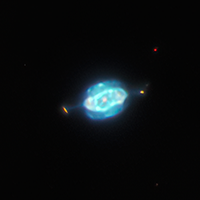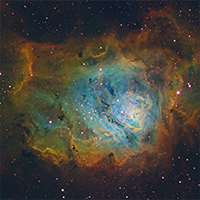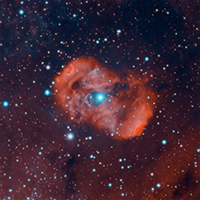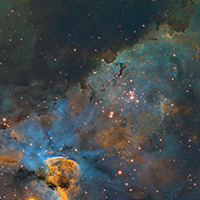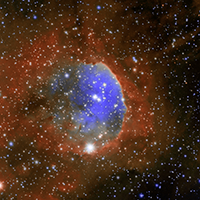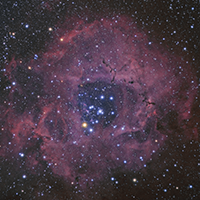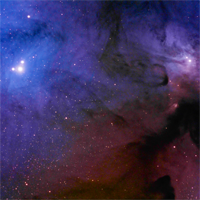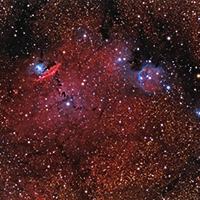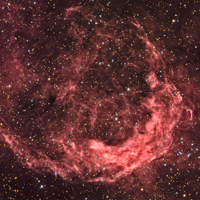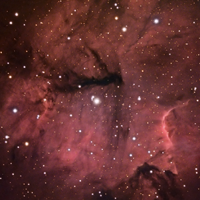Tagged: Emission
03-Aug-2016
Almost everyone has a go at imaging the Trifid nebula, which is composed of 3 different type of nebulae; emission, reflection, and absorption. When I noticed some faint red glow in the background, I decided to try integrating some long hydrogen emission line frames to see if I could get any structure out of it. I'm quite happy with the resulting background structures!
15-Feb-2021
Stars such as our Sun do not contain enough mass to finish their lives in the glorious explosions known as supernovae. However, they are still able to salute their imminent demise into dense, Earth-sized embers called white dwarfs by first expelling colourful shells of gas known as planetary nebulae.
27-Sep-2020
The Saturn Nebula is a tiny but complex planetary nebula, ~4000 light years away in Aquarius. The Saturn Nebula gets its name from its resemblance to the planet Saturn to the observer.
27-Aug-2019
The Lagoon Nebula is an active stellar nursery spanning 60 light years across. This false color photograph shows the interplay of three gasses: hydrogen-alpha in green, sulfur-II in red, and oxygen-III in blue.
02-Jul-2019
4200 light years distant, NGC 6164 is a bipolar emission nebula was created by a massive O-type star, 40 times as larger than the Sun.
19-Apr-2019
One of the largest nebulae in the sky, the Carina Nebula is visible to the naked eye in the southern sky.
19-Jul-2018
Shaped like a cats paw, NGC 6334 is a stellar nursery and emission nebula 5,500 light years away in the constellation Scorpius. This image comprises of emission line data for Sulfur-II, Hydrogen-alpha and Oxygen-III, mapped to red, green, and blue respectively.
13-Mar-2018
The Gabriela Mistral Nebula lies close to the Carina Nebula ~7500 light years distant in the far-southern sky. This image is a narrowband representation showing glowing ionised gasses, Hydrogen-alpha (orange), Sulfur-II (red), and Oxygen-III (blue).
21-Jan-2018
The Rosette Nebula is an emission nebula 3000 light years away. The central area of the nebula contains an open cluster of hot, blue stars which have cleared much of the center of its gas.
17-Aug-2017
Sh2-37 is a hydrogen emission nebula with two small blue reflection nebulae, embedded in a dusty background against the core of the Milky Way.
27-Apr-2017
Inside the Rho Ophiuchi cloud complex live the star clusters IC4604 (left) and IC4603 (right). Heading towards the bottom of the image shows the transition from blue reflection nebulae to red emission nebulae. Interspersed are dark absorption nebulae, blocking the light from the stars behind them.
09-Aug-2016
Next to the Lagoon Nebula, there lies the often overlooked collection of absorption, reflection and emission nebulae: NGC 6559, IC 1274, IC 1275, IC 4684, IC 4685, Barnard 303, LDN 227, LDN 213, and planetary nebula PN M 1-41.
13-Feb-2016
NGC 3199 is a hydrogen emission nebula, about 12,000 light-years away. The nebula is about 75 light-years across with a Wolf-Rayet star generating an intense stellar wind in the center of its ring.
22-Jan-2016
Gum 15 is a cloud of hydrogen gas 3,000 light-years from Earth. It is shaped by aggressive winds flowing from the stars within and around it.
04-Jul-2018
NGC 6188 is a large emission nebula of compressed molecular clouds 4,000 light years away in the constellation Ara. This image spans around 3 full moons and comprises of emission line data for Sulfur-II, Hydrogen-alpha and Oxygen-III, mapped to red, green, and blue respectively.


